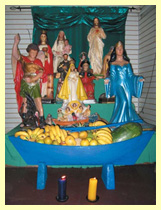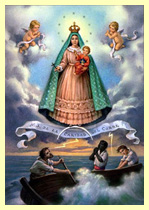Introduction:
 La Caridad Del Cobre has many paths in Santeria, one them being Oshun. Santeria sycretizes Catholicism with traditional African religions. However, it looks different from both. African old myths of a magical superstition blend with depictions of Catholic saints. Santeria originated when Yorubans were brought from Africa to colonial Cuba as slaves and were forced to adapt to Catholicism. Slaves saw parallels between their traditional African religions and European Catholicism. Catholics believe in one God with intermediaries operating between the supreme God and the believers. Afro-Cubans sycretized Yoruban religious figures with Catholic saints. To this day, many Cubans practice Santeria.
La Caridad Del Cobre has many paths in Santeria, one them being Oshun. Santeria sycretizes Catholicism with traditional African religions. However, it looks different from both. African old myths of a magical superstition blend with depictions of Catholic saints. Santeria originated when Yorubans were brought from Africa to colonial Cuba as slaves and were forced to adapt to Catholicism. Slaves saw parallels between their traditional African religions and European Catholicism. Catholics believe in one God with intermediaries operating between the supreme God and the believers. Afro-Cubans sycretized Yoruban religious figures with Catholic saints. To this day, many Cubans practice Santeria.
History:
 Around the year 1600, two brothers and their slave, Juan de Hoyos, Rodrigo, and Juan de Moreno, were out at bay when they encountered a storm. The storm was so violent that it threatened to destroy their small boat. They began to pray for the Virgin Mary’s protection when the storm suddenly cleared. With the storm cleared, they could see a strange object in the water. Upon getting closer to the object they discovered it was a statue of the Virgin Mary with a gold cross in one hand and an infant Jesus in the other arm. The statue was dressed in real cloth, had real hair, and the skin color of a racially mixed woman. Amazingly, despite having been in the water the statue was dry. The statue also contained an inscription that read Yo soy la Virgen de la Caridad (I am the Virgin of Charity). The boys brought the statue back to El Cobre, where a chapel was built for the statue.
Around the year 1600, two brothers and their slave, Juan de Hoyos, Rodrigo, and Juan de Moreno, were out at bay when they encountered a storm. The storm was so violent that it threatened to destroy their small boat. They began to pray for the Virgin Mary’s protection when the storm suddenly cleared. With the storm cleared, they could see a strange object in the water. Upon getting closer to the object they discovered it was a statue of the Virgin Mary with a gold cross in one hand and an infant Jesus in the other arm. The statue was dressed in real cloth, had real hair, and the skin color of a racially mixed woman. Amazingly, despite having been in the water the statue was dry. The statue also contained an inscription that read Yo soy la Virgen de la Caridad (I am the Virgin of Charity). The boys brought the statue back to El Cobre, where a chapel was built for the statue.
Syncretism:
Oshun embodies sensuality and feminine beauty. She teaches that love is the foundation of a life of joy. She is the love which exists between two individuals, the chemistry that sparks sexual passion. Oshun also symbolizes hope for those in exile. She is irresistible to human and orishas when she dances and passes her honey dipped fingers across the lips pf whoever she wishes to seduce.
Since her favorite food was squash, she is worshipped with having a honey filled Squash on her altar. Her chief festival, celebrates the arrival of the ancestral family on the banks of Oshun's river since she was born and is one of the goddesses of the river. Her day is Saturday both in Cuba and Brazil because it is most propitious for love. Five is Oshun’s number, sacrifices made to her and payments made to her should be divisible by 5.
Significance:
Our Lady of Charity was declared the patron saint of Cuba in 1916. She has become a symbol for Cuba, regardless of race or social class. Freedom fighters even wore images of her on their clothing while fighting for Cuban independence. For exiled Cubans, she's a connection to their Cuban soil. Even today people still gather on Our Lady of Charity’s feast day, September 8th, to celebrate. Our Lady of Charity provides support, comfort and allows those living on a foreign to stay connected with their homeland.
Works Cited:
- De La Torre, Miguel A. "Ochún: (N) Either the (M)Other of All Cubans (n)or the Bleached Virgin." Journal of the American Academy of Religion 69.4 (2001): 837. <http://jaar.oxfordjournals.org/cgi/reprint/69/4/837>. Web. 8 Dec. 2009.
- De La Torre, Miguel A. Santería: the beliefs and rituals of a growing religion in America. Michigan:Wm. B. Eerdmans Publishing, 2004.
- Ayorinde, Christine. Afro-Cuban Religiosity, Revolution, and National Identity. Florida: University Press of Florida, 2004.

